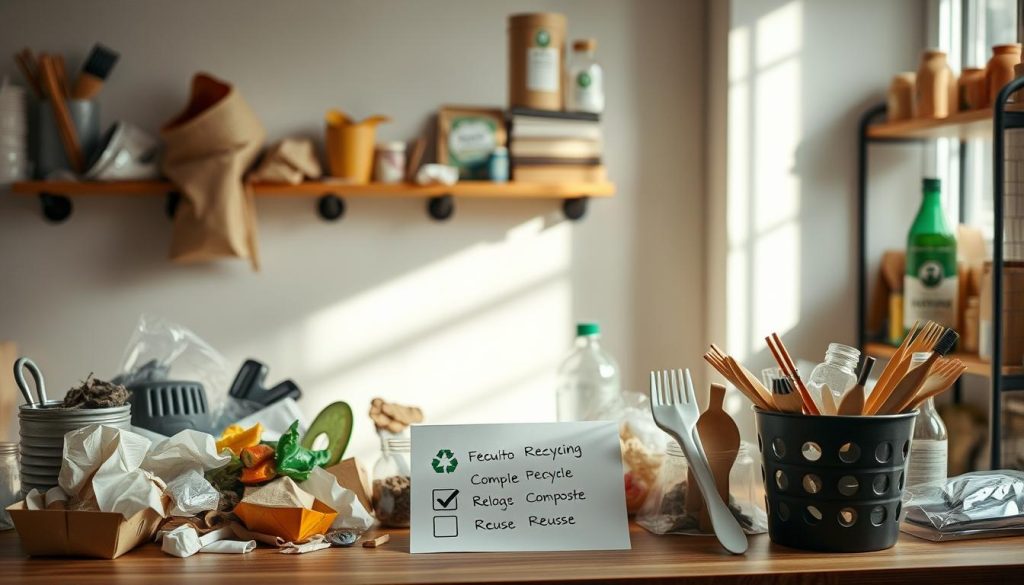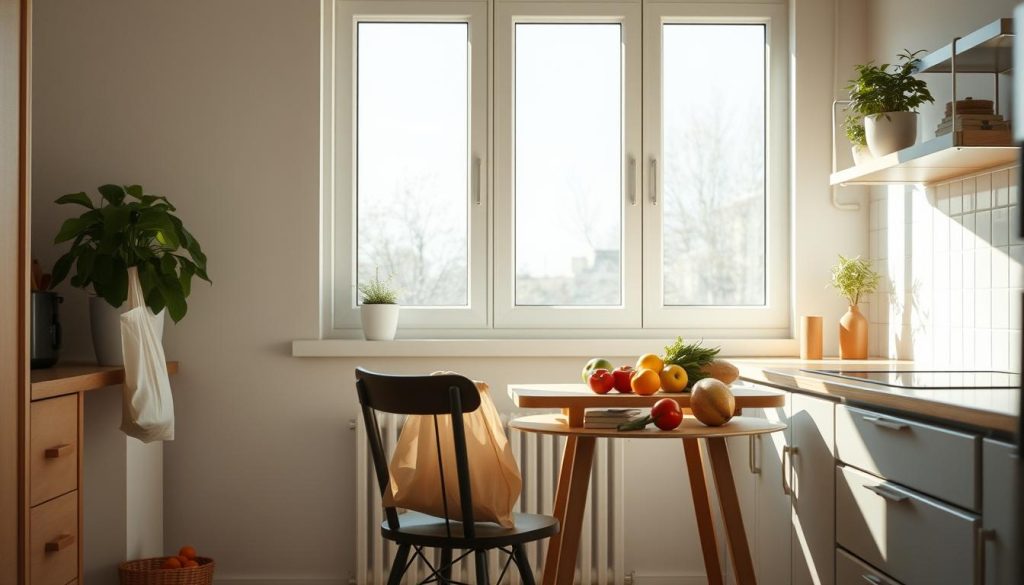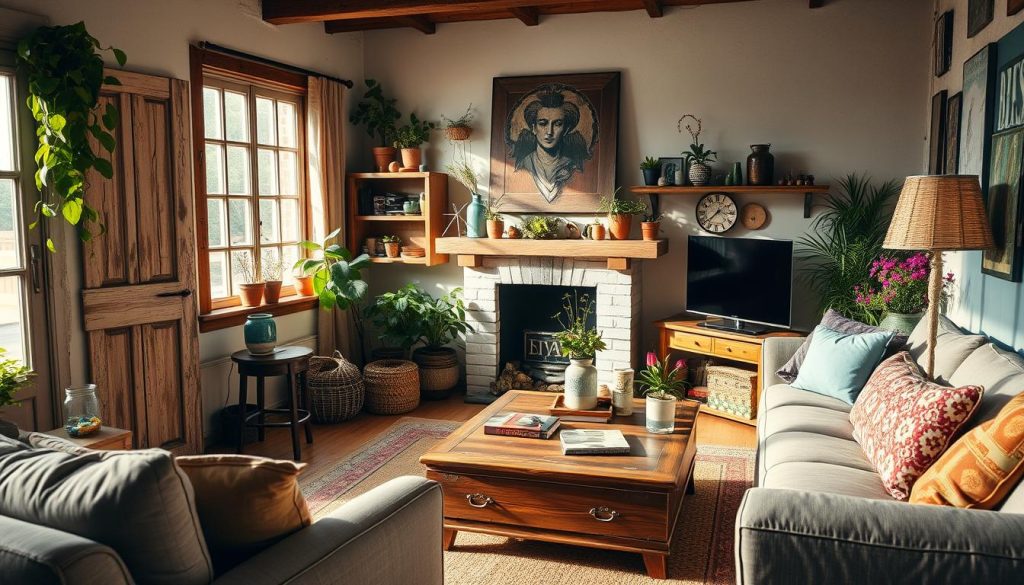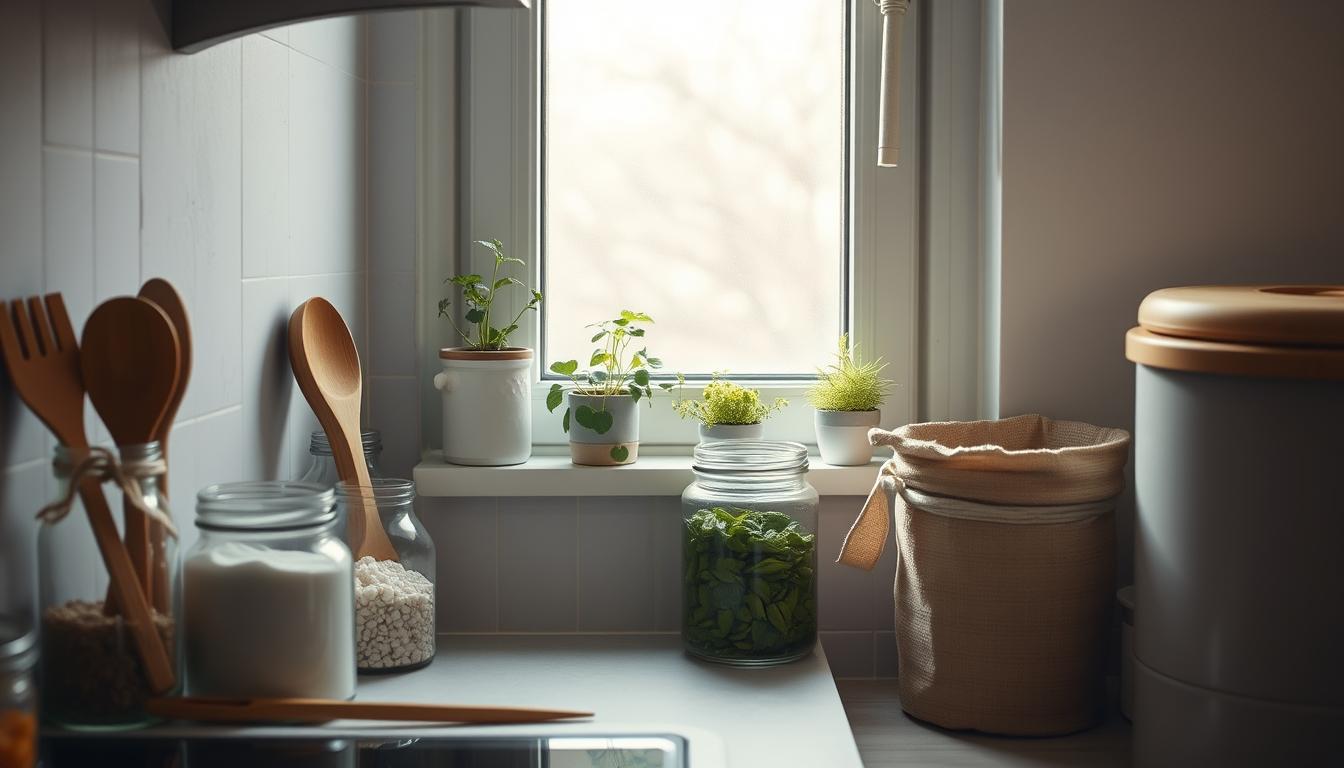I’ve always been drawn to minimal waste living. It’s more than recycling; it’s changing how we think about using things. By choosing eco-friendly options, we can lessen our harm to the environment.
Sustainable living is more than a trend; it’s essential for our planet. We can all help by making simple, thoughtful choices. Swapping disposable items for reusable ones and composting food scraps are just a few ways to live with less waste.
In this guide, I’ll share easy tips to help you live more sustainably. Whether you’re just starting or want to improve, you’ll find useful advice. Let’s see how small actions can make a big difference in protecting our planet.
Understanding Minimal Waste: A Path to Sustainable Living
I’m excited to explore the world of minimal waste. It’s a key step towards sustainable living. It helps us live in a way that’s better for our planet.
Defining Minimal Waste
Minimal waste means throwing away less. It’s a big part of living zero waste. We aim to use less, reuse more, and recycle better. This way, we live in harmony with Earth.
Environmental Impact of Excess Waste
Our throwaway culture is harming the Earth. Landfills are getting full fast. Oceans are filled with plastic. Animals are dying from eating our trash. By choosing minimal waste, we can stop this damage and protect our planet.
Benefits of a Low-Impact Lifestyle
Living sustainably has many benefits. It saves money by avoiding unnecessary buys. It also makes our homes less cluttered. And it gives us peace of mind, knowing we’re helping the planet. Small changes can make a big difference in our journey towards a circular economy.
- Save money on unnecessary purchases
- Reduce clutter in your home
- Lower your carbon footprint
- Support eco-friendly businesses
- Inspire others to join the movement
Understanding minimal waste is our first step towards a sustainable future. It benefits us all, from saving money to saving our planet. Let’s see how we can make these positive changes in our daily lives.
Getting Started: Assessing Your Current Waste Habits

I’m excited to help you check your waste habits. This step is key to reducing waste. Let’s explore how to do a simple waste audit at home.
Start by keeping a waste diary for a week. Write down everything you throw away, like food scraps and packaging. This will make you more aware of your habits and show where you can improve.
Then, sort your trash into recyclables, compostables, and landfill waste. This might surprise you with how much can be recycled or composted. With a bit of effort, you can reduce a lot of waste.
To get started, here’s a simple waste audit template:
| Waste Category | Amount (lbs) | Potential for Reduction |
|---|---|---|
| Plastic Packaging | 3.5 | High – Switch to bulk buying |
| Food Scraps | 5.2 | Medium – Start composting |
| Paper Products | 2.8 | Low – Already recycling most |
By doing this audit, you’re making a big step towards less waste. It’s not about being perfect, but about making progress. Every small change helps a lot over time.
The Power of Reduce: Minimizing Consumption

Reducing what we consume is the first step in the reduce-reuse-recycle mantra. It’s a powerful way to live greener and lessen our environmental footprint. By buying less, we can greatly reduce our waste.
Identifying Unnecessary Purchases
I often ask myself, “Do I really need this?” before buying something new. It’s surprising how many items we buy out of habit or impulse. By thinking before we buy, we can avoid cluttering our homes with unnecessary items.
Embracing Quality Over Quantity
Investing in high-quality items that last longer is key to the reduce-reuse-recycle lifestyle. I’ve found that spending a bit more on durable goods saves money and reduces waste. This approach works for everything from clothes to appliances.
Strategies for Mindful Shopping
Mindful shopping is crucial for living green. I make shopping lists to avoid impulse buys and use reusable bags to cut down on plastic waste. Shopping secondhand is also a great way to buy what I need while reducing consumption.
| Mindful Shopping Tips | Benefits |
|---|---|
| Make a shopping list | Avoid impulse purchases |
| Use reusable bags | Reduce plastic waste |
| Buy secondhand | Lower environmental impact |
| Choose quality items | Less frequent replacements |
By using these strategies, we can greatly reduce our consumption and live more sustainably. Every small change we make can have a big impact on our environment.
Reuse Revolution: Giving Items a Second Life

Embracing a zero waste lifestyle doesn’t mean throwing everything away. It’s about finding new uses for what we already have. This not only cuts down on waste but also saves money and boosts our creativity.
In my quest for sustainable living, I’ve discovered many ways to give old items new life. Old jars now hold bulk foods. Clothes that are no longer wearable become cleaning rags or parts of quilts. Even broken ceramics get a second chance in mosaic art.
Here are some reuse ideas I love:
- Turn empty tin cans into planters for herbs
- Use old newspapers as gift wrap
- Repurpose glass bottles as vases or candle holders
- Convert wooden pallets into outdoor furniture
By reusing items, we make them last longer and reduce our environmental footprint. It’s a simple yet effective way to help our planet.
| Item | Original Use | New Purpose |
|---|---|---|
| Glass Jars | Food Storage | Organizers, Vases, Candle Holders |
| Plastic Bottles | Beverage Containers | Planters, Bird Feeders, Watering Cans |
| Old Clothing | Apparel | Cleaning Rags, Quilts, Pet Beds |
| Cardboard Boxes | Packaging | Storage Units, Cat Scratching Posts, Compost |
Every item we reuse means one less in the landfill. Let’s get creative and make reusing a fun part of our zero waste journey!
Recycle Right: Mastering Proper Recycling Techniques
Recycling is key to reducing waste. Knowing how to recycle right can really help. Let’s explore the basics of recycling.
Understanding Recycling Symbols and Guidelines
Recycling symbols can be tricky, but they’re essential. The triangle of arrows with a number inside is common. This number tells you what plastic type it is.
Numbers 1 and 2 are usually recyclable. But numbers 3-7 might not be. Always check your local recycling rules to see what they accept.
Common Recycling Mistakes to Avoid
Some mistakes can ruin a whole batch of recyclables. Here are a few to avoid:
- Putting greasy pizza boxes in the recycling bin
- Recycling items with food residue
- Including plastic bags with other recyclables
- Tossing in small items like bottle caps
Always rinse containers before recycling to prevent contamination.
Setting Up an Efficient Recycling System at Home
Having a good recycling system at home is important. Here’s what I suggest:
- Using separate bins for different materials
- Placing recycling bins next to trash cans for convenience
- Creating a designated space for items that need special recycling
- Educating family members about proper recycling practices
By following these tips, we can make a big difference. We can help reduce waste and make the future greener.
Zero Waste Kitchen: Transforming Your Culinary Space
The kitchen is often the biggest source of household waste. By using minimal waste and eco-friendly practices, we can greatly reduce our environmental impact. Let’s look at some practical ways to make our kitchens greener.
Meal planning is a big help. I plan my meals for the week, which means I only buy what I need. This reduces food waste and packaging. I also use reusable bags and containers when shopping.
Choosing loose produce over pre-packaged items also cuts down on plastic waste. This simple change makes a big difference.
Proper food storage is key to reducing waste. I use glass containers and beeswax wraps to keep food fresh. For bulk items, I store them in airtight jars. This keeps my kitchen tidy and reduces waste.
Being creative with leftovers is another great way to reduce waste. I turn leftover veggies into soups or stir-fries. Stale bread becomes croutons or breadcrumbs. This way, almost nothing is wasted.
| Kitchen Item | Eco-Friendly Alternative | Benefits |
|---|---|---|
| Plastic wrap | Beeswax wraps | Reusable, biodegradable |
| Paper towels | Cloth napkins | Washable, long-lasting |
| Plastic containers | Glass containers | Durable, non-toxic |
| Disposable sponges | Loofah scrubbers | Compostable, effective cleaning |
By making these small changes, I’ve turned my kitchen into an eco-friendly space. It’s surprising how much of a difference these changes can make in reducing our environmental footprint.
Minimal Waste: Simple Swaps for Everyday Items
Starting a low-impact lifestyle is easy with small changes. Swapping everyday items for eco-friendly ones is a great first step. Let’s look at some simple swaps that can make a big difference.
Plastic-free alternatives for personal care
In my bathroom, I’ve ditched plastic bottles for solid shampoo bars and bamboo toothbrushes. These changes cut down on plastic waste and last longer. For skincare, I use reusable cotton pads and biodegradable face wipes.
Eco-friendly options for household cleaning
Cleaning products often come in plastic. I now make my own all-purpose cleaner with vinegar and citrus peels. For dishes, I use a wooden dish brush and natural dish soap in a glass bottle. These changes have cut down my household waste a lot.
Sustainable choices for on-the-go living
When I’m out, I carry a reusable water bottle and coffee cup. I also have bamboo utensils in my bag to avoid single-use plastics. For groceries, I use cloth produce bags and bring my own containers for bulk items. These simple swaps have made my on-the-go lifestyle more sustainable.
By making these easy changes, I’ve taken big steps towards a low-impact lifestyle. Green living is simple – it’s about making mindful choices every day.
Composting 101: Turning Food Scraps into Garden Gold
Composting is a great way to cut down on waste and help the environment. It’s simple and turns kitchen waste into rich soil for my garden. Let’s explore the basics of composting and how to start at home.
I pick a spot in my yard for my compost bin or pile. I mix green materials like fruit peels and coffee grounds with brown ones like dried leaves or shredded paper. This mix is key for decomposition.
Keeping my compost moist and turning it often makes it break down faster. After a few months, I get dark, crumbly compost for my plants. It’s incredible to see food waste turn into something valuable for my garden!
- Green materials: Fruit and vegetable scraps, grass clippings
- Brown materials: Dry leaves, cardboard, wood chips
- Avoid: Meat, dairy, oils, and diseased plants
If you don’t have a yard, vermicomposting with worms is a good indoor choice. I use a small bin with red wiggler worms to compost my kitchen scraps. It’s clean and works well in apartments.
Composting has reduced my household waste by half and made my garden soil better. It’s good for both waste reduction and my plants. Try composting and see your food scraps become garden gold!
Beyond the Home: Spreading Minimal Waste Practices
Sustainable living isn’t just about our homes. It’s time to take it to our communities. By sharing what we know, we can make a big difference.
At work, I use a reusable coffee mug and lunch containers. This simple action starts conversations about waste reduction. I even suggested composting in our kitchen, and it’s been a success!
In schools, I teach kids about recycling and composting. They quickly learn and share this knowledge with their families. This helps shape a future generation that cares about the planet.
Community events are perfect for spreading the word about living sustainably. I set up booths at local fairs to show easy ways to reduce waste. Seeing people excited about making changes is truly rewarding. Together, we can make our future cleaner and greener.
